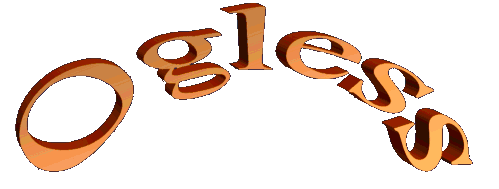
Welcome to the world of Ogless; with unrivaled flexibility and variability Ogless is a screen saver you won't get tired of.
Ogless packs a lot of power into such a humble thing as a screen saver. Compare this with some of the basic savers that come with Windows that repeat themselves continuously and have no configuration options at all.
Click on Settings for help on changing Ogless's configuration settings. Click on Install for help on installing and uninstalling Ogless on your PC.
People who remember computers from the 1970s were all too used to finding a monitor with an image 'burnt into' the screen. In those days these were Cathode Ray Tubes (CRT) and the image was made by steering an electron beam over the screen. If the same screen image is shown for a long time the screen phosphor that radiates the light is damaged and whatever has been displayed for a long time shows through any other information displayed - it gets burnt in. The earliest and still most effective screen savers just 'blank' the screen or automatically turn off the monitor to prevent screen damage.
However, the knowledge that the computer is normally idle when a screen saver is run haunted programmers. Why not use the 'idle' time to display something more interesting than just a blank screen? If an image moves around the screen it will not get burnt into one place. The other less interesting reason for screen savers is security - if someone leaves their desk for a few minutes they may not want the screen contents displayed for all and sundry to see.
Ogless is designed for high specification PCs running Windows ®.
Some of the effects use up a high proportion of available processor power and memory space to achieve the interesting screen effects.
If your PC is carrying out useful work when it is left unattended run only some of the less demanding saver effects or run savers at lower speed settings to reduce the effect of running them. A special 'low load' scheme is provided that can be used to reduce processor load.
Graphics capabilities have come a long way from the first PC that supported two colors (black and green !) or at most four. Unfortunately Windows was devised when graphics cards that only had a very small amount of memory. Early versions only supported 256 colors at a 320 by 200 resolution - because of the 64K video memory limit.
Some of the savers manipulate the screen image directly and need to know how the video memory is organized and may not work on non standard numbers of colors. The colors supported are : 32,768 (15 bit), 65,536 (16 bit), 16,777,216 (24 bit) and 32bit. You can check how many colors are available on your PC by using the 'Settings' tab on the Screen properties sheet.
The most popular screen setting with Windows was 1024 by 768 pixels. Ogless was devised with high screen resolutions in mind and so you may have problems with very small or large settings. 860 by 480 is the smallest suitable setting, 1280 by 1024 the largest.
Copyright © Silurian Software (silurian.com) 2008-2021